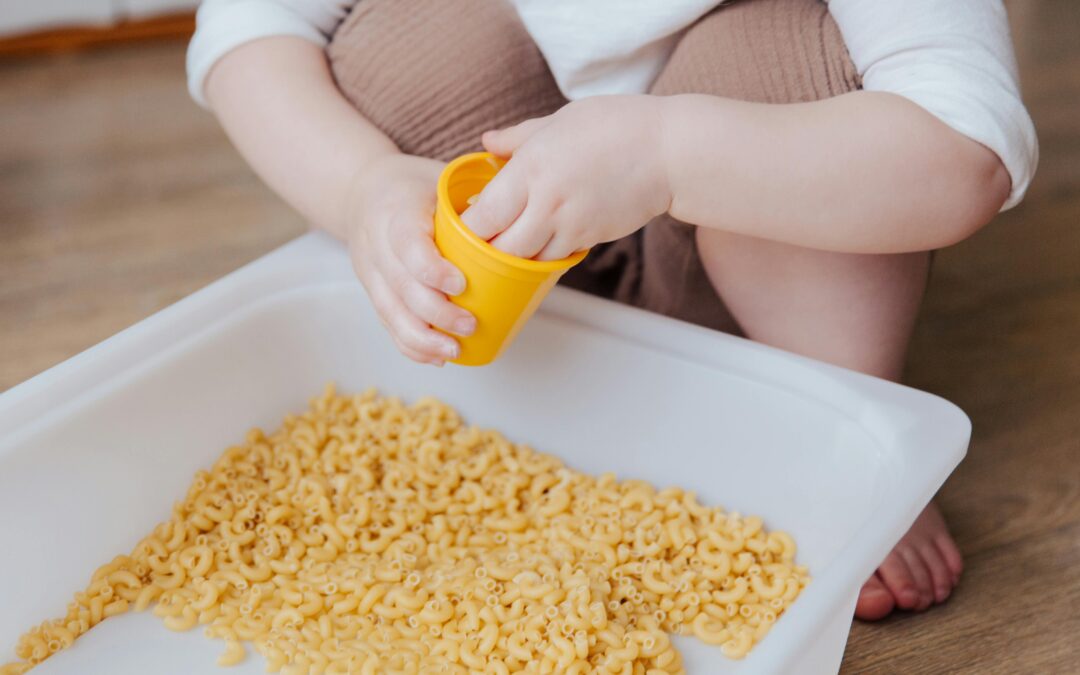Introduction
Sensory play is a crucial component of childhood development, offering numerous benefits, especially for children with special needs. Engaging in sensory activities helps these children process sensory information, develop motor skills, and improve cognitive functions. This blog post will explore various DIY sensory play ideas, offer tips for creating a sensory-friendly space at home, and highlight the benefits of sensory play for children with special needs.
DIY Sensory Play Ideas
1. Sensory Bins
Sensory bins are containers filled with materials that stimulate the senses. They are easy to create and can be tailored to suit individual preferences and needs.
Materials:
- A large, shallow bin or container
- Fillers (e.g., rice, beans, sand, water beads, or shredded paper)
- Tools (e.g., scoops, spoons, small toys, or figurines)
How to Create a Sensory Bin:
- Choose a filler that is safe and appropriate for the child’s age and sensory needs.
- Add tools and toys that can be used for scooping, pouring, and exploring.
- Encourage the child to use their hands and tools to manipulate the materials, fostering tactile exploration and fine motor skills.
Ideas for Themed Sensory Bins:
- Beach Bin: Use sand, shells, small shovels, and beach toys.
- Farm Bin: Fill with dried corn, plastic animals, and toy tractors.
- Color Sorting Bin: Use colored rice or pasta and small containers for sorting by color.
2. Tactile Activities
Tactile activities involve hands-on exploration and manipulation of materials, which can help children with sensory processing difficulties.
Examples:
Playdough:
- Materials: Flour, salt, water, oil, food coloring, and cream of tartar.
- Instructions: Mix the ingredients to create a dough. Add food coloring for visual stimulation.
- Activity: Encourage the child to knead, roll, and shape the playdough. Offer tools like cookie cutters and rolling pins for added fun.
Slime:
- Materials: Glue, baking soda, contact lens solution, and food coloring.
- Instructions: Mix the glue and food coloring, then add baking soda. Slowly add the contact lens solution until the slime forms.
- Activity: Allow the child to stretch, squeeze, and manipulate the slime, promoting tactile exploration.
Sensory Bags:
- Materials: Resealable plastic bags, hair gel or water, small toys, and duct tape.
- Instructions: Fill the bags with hair gel or water and small toys, then seal them securely with duct tape.
- Activity: Encourage the child to press and squish the bags, searching for hidden objects inside.
3. Sensory Bottles
Sensory bottles are sealed containers filled with materials that create visual and auditory stimulation.
Materials:
- Clear plastic bottles
- Fillers (e.g., water, glitter, beads, sequins, or small toys)
- Glue (for sealing the bottles)
How to Create a Sensory Bottle:
- Fill the bottle with the chosen materials.
- Seal the bottle securely with glue to prevent spills.
- Encourage the child to shake, roll, and observe the contents, fostering visual tracking and auditory processing.
Ideas for Sensory Bottles:
- Calm Down Bottle: Fill with water, glitter, and food coloring. The swirling glitter can have a calming effect.
- I-Spy Bottle: Fill with rice and small toys or beads. Encourage the child to search for specific items.
- Wave Bottle: Fill with water and a few drops of oil. The oil creates a wave-like effect when the bottle is tilted.
Creating a Sensory-Friendly Space at Home
Designing a sensory-friendly space at home can provide a safe and comforting environment for children with sensory processing difficulties. Here are some tips to create such a space:
1. Choose the Right Location
Select a quiet, low-traffic area in your home where the child can retreat and feel secure. This space should be free from distractions and excessive noise.
2. Use Soothing Colors and Lighting
Opt for soft, muted colors for walls and furnishings to create a calming atmosphere. Use adjustable lighting to control brightness, and consider incorporating sensory lighting tools such as lava lamps or fiber optic lights.
3. Incorporate Comfortable Seating
Provide comfortable seating options like bean bags, floor cushions, or rocking chairs. These can offer proprioceptive input and help the child feel grounded and relaxed.
4. Provide a Variety of Sensory Tools
Equip the space with a range of sensory tools that cater to different sensory needs. Some ideas include:
- Weighted Blankets: These provide deep pressure input, which can be calming.
- Fidget Toys: These can help with focus and self-regulation.
- Soft Textiles: Include soft blankets, pillows, and stuffed animals for tactile comfort.
- Noise-Canceling Headphones: These can help reduce auditory overload.
5. Create a Safe Environment
Ensure the space is safe by removing any sharp objects or hazardous materials. Use non-slip mats and secure heavy furniture to prevent accidents.
6. Set Up a Sensory Station
Designate an area within the space for sensory activities. This could include a small table for sensory bins, a shelf for sensory bottles, and storage for tactile materials like playdough and slime.
Benefits of Sensory Play for Children with Special Needs
Sensory play offers numerous benefits for children with special needs, including those with autism spectrum disorder (ASD), sensory processing disorder (SPD), and other developmental delays.
1. Enhances Sensory Processing
Sensory play helps children learn to process and respond to sensory information. By engaging in activities that stimulate different senses, children can improve their ability to integrate and make sense of sensory inputs.
2. Promotes Motor Skills Development
Many sensory activities involve fine and gross motor skills. For example, manipulating playdough strengthens hand muscles and improves coordination, while activities like pouring and scooping in sensory bins enhance hand-eye coordination and dexterity.
3. Supports Cognitive Development
Sensory play encourages exploration, problem-solving, and creativity. Children learn to think critically and develop cognitive skills as they interact with different materials and experiment with cause-and-effect relationships.
4. Improves Social Skills
Engaging in sensory play with peers or caregivers can enhance social interactions. Children learn to share, take turns, and communicate their needs and preferences. Group sensory activities can also foster teamwork and collaboration.
5. Reduces Anxiety and Stress
Sensory play can have a calming effect on children, helping to reduce anxiety and stress. Activities that provide deep pressure input, such as using a weighted blanket or squeezing a stress ball, can be particularly soothing.
6. Encourages Language Development
As children explore and describe their sensory experiences, they develop language skills. Sensory play provides opportunities for children to expand their vocabulary, articulate their thoughts, and engage in meaningful conversations.
Conclusion
Sensory-friendly activities are invaluable for supporting the development and well-being of children with special needs. DIY sensory play ideas like sensory bins, tactile activities, and sensory bottles offer endless possibilities for engagement and learning. Creating a sensory-friendly space at home ensures that children have a safe and comforting environment to explore their senses and develop essential skills. The benefits of sensory play extend beyond immediate enjoyment, contributing to long-term cognitive, motor, social, and emotional growth. By incorporating sensory activities into daily routines, parents and caregivers can provide children with the tools they need to thrive.

